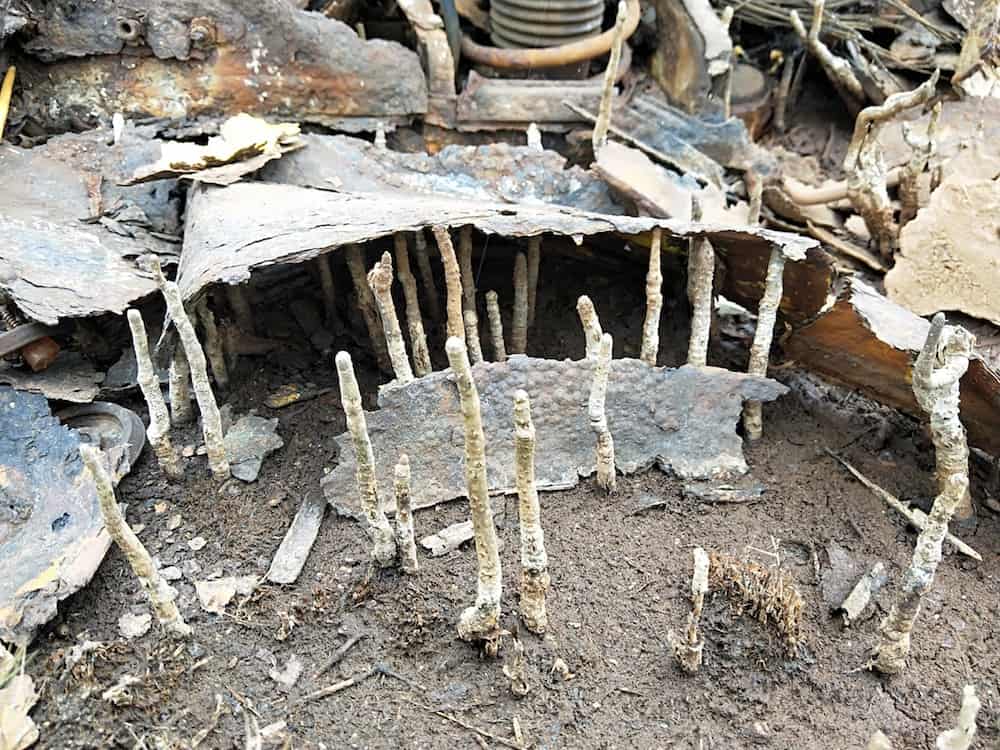by Sharon Jewell for the The Friendly Bay Islander
On Tuesday August 27, a group of four inquisitive and peculiarly talented women from regions as far as Chile and New York, alighted on Canaipa Island. With their large van, Big Mama, loaded for a special kind of journey, they came in search of something not yet known, but certain of finding links to their global coastal research. Ready to be alert to the island’s magic, from the newly blossoming wildflowers of Turtle Swamp, to the sprawling mangroves of the littoral shores; from the decaying carcass of an automobile stranded in the mud flats to the creamy white clay of the western shores, they gathered notes, filmed, recorded sound.
They are members of the research program Ensayos, which seeks collaborative opportunities between art and science, with particular attention to ecologies and the complex world of post-colonialism. While the centre of their studies is the remote region of Tierra del Fuego, they see the ecological and humanitarian concerns there as sharing salient characteristics with issues across the globe; similarities that nourish mutual understanding and provide triggers for insight and artistic collaboration. Who might have thought that looking at a small island in Southern Moreton Bay might feed into the stories of such far-away places as the islands and shores of the Americas’ southern-most reaches?
The visitors were Camila Marambio (Chile / Australia), curator and founder of the program, Ensayos; Christy Gast, (New York), a felter and weaver, with a research interest in “contested landscapes”; Carla Machiavello (Chile / New York), an art historian with a special interest in Latin American contemporary art; and Caitlin Franzman (Australia), an artist whose practice involves the creation of spaces of meeting and what she calls “Divination”. She also teaches art at QUT. Their observations will form part of an international investigation into the special types of learning and knowledges that come from observing and interpreting coastal and island contexts.
Whilst on the island, they met with Canaipa Mudlines Art and Environment artists, Sharon Jewell and Tricia Dobson and exchanged observations and experiences of coastal and particularly island habitation. There was a visit to Tricia Dobson’s studio, where a group of artists was involved in weaving and printing projects of their own. Tricia’s extraordinary weavings were of considerable interest here, and questions surrounding techniques and materials both traditional and experimental, gave rise to lively conversation. Paul Andrew was able to shed some light on local histories while Nick Dobson clarified the names and occurrences of the wild flowers we had seen in the forests of Turtle Swamp and Melomy’s.
Throughout the day, we moved across and around the island, and I was to choose some key sites; sites that would reveal the diversity and richness of this place. In my involvement with Canaipa Mudlines over the past three years, I have come to know and love not only particular sites, but the ways they connect, and merge and also diversify, sometimes quite suddenly. As a guide, however, my attention was aroused to the island in a different way, through the inquiring eyes of others, through their slow and thorough apprehension of small things, and the ways they found to document and record and connect with these things. At one point we were all perched within and around the branches of a sprawling mangrove tree out on a remote stretch of the eastern littoral. There we focused on the crisp and distant fibres of sound that encircled us, and recorded our own voices in imitation of these sounds. It was like painting the landscape, but a painting for the ears instead of the eyes! At the end of the day, as we sat around a small fire, reflecting on the experience and preparing for goodbyes, it occurred to me that one gets to know a place not only by looking, but by looking, listening, pausing, with others, through the senses of others.
The Ensayos group are now travelling north to continue their work exploring coastal health and environmental issues facing coastal communities. Along with findings and responses to their stay on Minjerriba prior to coming to Canaipa, their work is given expression in a collaborative exhibition that opened on Saturday September 7, at Milani Gallery in Brisbane’s West End. The exhibition will culminate with a performance on Saturday September 28. The details along with their website link are below:
Ensayos, Everything is possibly an oracle, Milani Gallery, closing event 28/ 09, 2pm, 270 Montague Road, West End.
Ensayos website: https://ensayostierradelfuego.net


A lovely way to tell the the story you saw in image song and sound recording. Thank you
Thank you Mark!